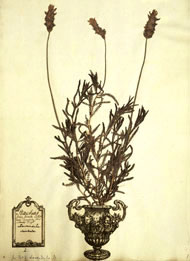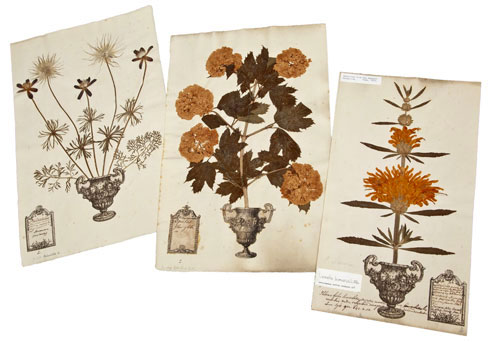George Clifford’s herbarium sheet
The pressed plants in George Clifford’s collection helped the great Swedish botanist Carl Linnaeus transform the way we classify and name the natural world. We still use Linnaeus' naming system today.

George Clifford's garden in the Netherlands. © Linnaean Society of London
Exotic plants
George Clifford was a director of the Dutch East India Company, which was established in the early 1600s to protect and control Dutch trade in Asia. His private zoo and botanical garden were famous in Holland for the exotic animals and plants brought back on the company’s ships.
As a doctor, Carl Linnaeus was interested in plants used in medicine. When Clifford asked Linnaeus to organise his plant collections, Linnaeus jumped at the opportunity to study plants new to Europe.
A botanical directory

First recorded specimen of French lavender, Lavandula dentata, named by Carl Linnaeus.
In 1738, Linnaeus produced Hortus Cliffortianus, a catalogue of 3,461 plants in Clifford’s garden and herbarium collection of dried specimens. It was an important account of plants newly cultivated in Europe. Thanks to Linnaeus, many of the plants in this collection are now invaluable type specimens – the first of their species to be described and named.
Bite-size names
Ambitiously, Linnaeus set out to expand on Hortus Cliffortianus by naming every other living plant.
At the time, plants were given long descriptive Latin names. For example, the humble tomato was called Solanum caule inermi herbaceo, foliis pinnatis incises, racemis simplicibus, which means ‘the solanum with the smooth stem which is herbaceous and has incised pinnate leaves’.
Linnaeus grew frustrated working with such bulky names. So he decided to use a more efficient system.

Guelder rose, Viburnum opulus, from the Clifford collection. Cited by Linnaeus in Species Plantarum, 1753.
He turned long names into a simple pair, or binomial. The first part, the genus, is shared between close relatives. The second part is the unique species name. So the tomato became Solanum lycopersicum, while its cousin the aubergine is Solanum melongena.
Naming nature
Linnaeus published his monumental Species Plantarum in 1753. It incorporated many of Clifford’s plants. Five years later he tackled giving Latin names to all animals.
His binomial system was ultimately adopted by other scientists and became a universal language for naming organisms. It is so effective we still use it.
Linnaeus hoped to name all living species, but there were far more than he could imagine. We still don’t know how many there are, but with the help of powerful microscopes and DNA analysis we are developing a better understanding of the relationships between them.
Taxonomists working towards Linnaeus’s goal still use the specimens he studied from Clifford’s herbarium, which are preserved at the Museum.
Further information
- See one of Clifford's herbarium sheets in our new Treasures Cadogan Gallery. The page will be changed regularly to prevent light damage.
- Watch a video about Linnaeus and discover more about his legacy.
- Find out how microscopy and DNA analysis help scientists today to identify and categorise species and view stunning electron microscopy images.
Vote for your favourite treasure
Is this your favourite Museum treasure? Let us know by voting in our poll.
